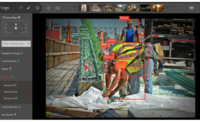Artificial intelligence-enhanced analytics are turning up in almost every aspect of construction, with major inroads in project planning and safety. But what if the recommendations from an AI came from your existing jobsite cameras?
No sector in construction technology has seen more consolidation in the last two years than reality capture. Oracle snagged Newmetrix back in October, DroneDeploy acquired StructionSite in November and Faro picked up HoloBuilder back in 2021. There are signs of reality capture becoming even more integrated into industry practices.
Yet EarthCam, the company best known for its jobsite cameras and time-lapse project videos, has been working on its own advancements all this time. The company has added AI-enabled safety and security analytics to its jobsite cameras. These new features are included with the existing product, and don’t require anything more than taking advantage of EarthCam’s existing integrations with construction management platforms to use them fully.
In order to call out when safety protocols are not being followed, AI algorithms must be trained to visually recognize violations such as missing PPE, workers too close to operating equipment or a lack of steel-toed boots. This takes time. The algorithms need to be trained on numerous images of what safety violations look like, and many AI developers resort to image search engines or purchase synthetic data to train their systems. EarthCam, however, has a library of millions of images from jobsites cameras going back more than two decades.
Building Out the AI
EarthCam began exploring adding AI insights to its construction cameras in 2018, but development of the system really took off in 2020 when the pandemic prevented project executives and supervisors from going out to their sites as often as they would have liked.
“We were analyzing images and taking rain out, so that when we made a time lapse, it was more presentation ready,” says Brian Cury, CEO of EarthCam. “We automated that process first and then we built the model, we built all the tools to annotate things.”
Adding the capability to annotate images was just the first step. Next was the labor-intensive task of training an algorithm to spot safety violations. “We had about a dozen assistants, receptionists and marketing people who were all sent home [during the pandemic],” Cury says. “We gave them tools that we built to annotate images. We had a dozen people putting boxes around excavators, dumpsters, to train the AI.”
Because all of the images came from real jobsites with EarthCam installations, they were able to avoid the errors that can come from training a computer vision algorithm on the cleaner promotional shots of equipment or PPE found in catalogs or sales materials, Cury says.“We’ve got a constant feedback loop, so it’s getting better and better,” he says. “We are taking that [training data] to a team that shrinks it into a little piece of code [that runs] in a live camera’s computer.” Having the AI-based computer vision running onboard the cameras rather than waiting on server-side analyses saves time and allows for faster response times, explains Cury.
Both contractors and owners have started using EarthCam’s in-camera AI for safety and security applications. Online retailer Amazon.com and contractor Turner Construction are both customers.
“You’ve got live streaming of the data; recording of that information. And we’re parsing all of that data and creating charts and graphs and usable data so contractors can find out when something got there and how long it was there,” Cury says.
Project managers can get their EarthCam system set up to send out alerts for security personnel or other project team members. EarthCam also offers a self-contained AI Safety Trailer security package consisting of a 22-ft steel mast with 400-W solar panels to power three cameras that can cover a whole site.





